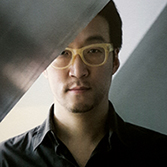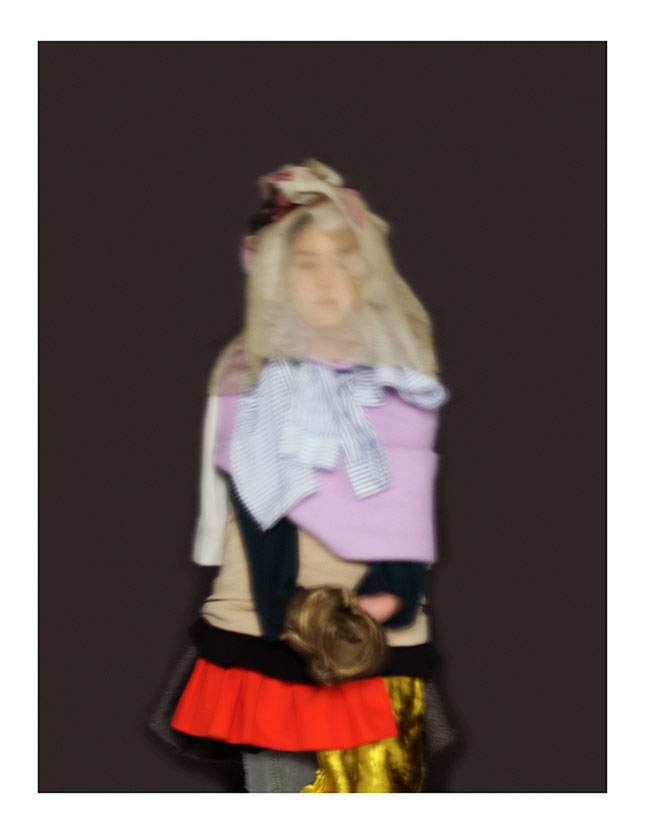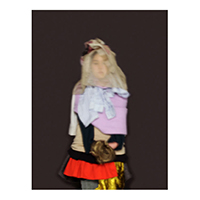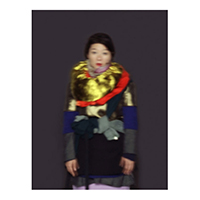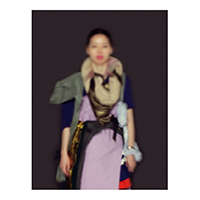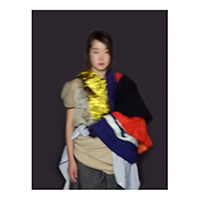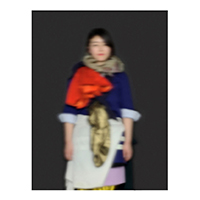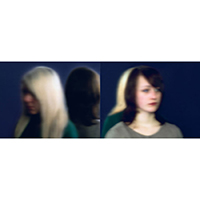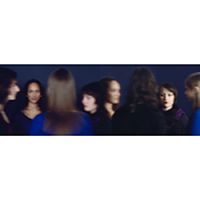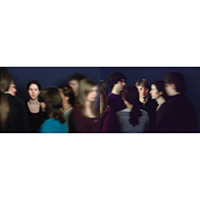Silent Dialogues -Thoughts about the Performative Works of Kyungwoo Chun-
Two people shake hands—this form of greeting is customary in many countries, principally in the West. It is an expression of openness and mutual respect. Upon a first encounter, the physical contact creates a certain closeness, yet preserves the necessary respect. The handshake thereby numbers among a multiplicity of rituals which help to organize our daily life, mostly in an unconscious manner. Conventions have an enduring effect on our association with our fellow men; they regulate the manner in which we communicate and live together. The Korean artist Kyungwoo Chun is interested in these relationships and makes them the theme of his works. From time to time, everyday activities and gestures are the point of departure for performances which he has been initiating for more than ten years now. These are temporally limited processes which may be carried out by individuals or groups. As a rule, the public is actively involved.
During the summer of 2009, the performance Greetings was carried out for the first time in the forecourt of the Bremer Kunsthalle. A total of twenty persons were asked to select from among the participants a partner who was unknown to them. Thereupon they were supposed to share a handshake for a period of twenty minutes. In addition, their hands were wrapped in plastic foil and firmly connected with each other. There were no further instructions. With the simplest of means, the greeting was transformed into a moment of unusual closeness and intensity. What was crucial for Kyungwoo Chun was not the subjects of the conversations which took place. Instead he was concerned with a conscious perception of the mutually shared time. The participants were supposed to experience with their own bodies the manner in which they approach a stranger—how they behave when they talk together for the first time; how it feels when one's gaze is returned, when one feels the warmth of another hand.
Already two years earlier, Kyungwoo Chun had carried out a performance which adhered to a comparable concept but was more intensive in its impact. Versus could be seen in various countries and cities from 2007 to 2012, among other places in New York, Barcelona, and Zürich, and has now come to a conclusion in Seoul. The procedure was identical each time. The participants were requested to sit down upon two benches placed opposite each other. They were supposed to place their head on the shoulder of their respective partner and to remain in this position for fifteen minutes—wordlessly, their eyes closed, and with as little movement as possible.
Viewed from the outside, the group seemed to be an island of calm and contemplation. At Times Square in New York, the performance stood in remarkable contrast to the vast city with its loud traffic and numerous pedestrians. But what appeared at a first glance to be harmonious and could be misunderstood as a communal reconciliation in fact represented a genuine challenge for the participants. The physical contact required by the artist generally occurs only among friends and close aquaintances. In the case of strangers, one is always inclined to be discreet and automatically to maintain a certain distance.
Whoever was ready to become involved in this sort of a violation of borders had the opportunity of experiencing the person sitting opposite in a special manner. But that was not all. As time passed, one perceived not only one's partner, but also oneself with increased intensity. There was a growing sensitivity to one's own body odor, to the slow rhythm of inhalation and exhalation, to the heartbeat felt in the ear, and to the tiring burden imposed by the limbs of the body. Many people had a positive response to the intimacy of the encounter, while for others the situation was linked to an extreme inner tension. These diverse reactions and sensations are also one of the reasons why Kyungwoo Chun repeatedly realizes his performances in various countries and cultural contexts.
The work Versus is inspired by the Chinese character "Ren" (人) and is translated as "human being." The form of the character resembles a walking figure but can also be viewed as two persons leaning against each other and thereby maintaining their equilibrium. This concept is the basis for the performance. It presupposes that everyone needs a counterpart in life, someone in whom one recognizes oneself as a human being with all one's strengths and weaknesses, individual emotions and desires. An encounter with the Other is always a confrontation with oneself. The art of Kyungwoo Chun is exemplary in this regard. The very presence and cooperation of the participants already gives rise to a space of thoughtfulness which endures for a short while and then disappears forever. Photographs, videos, and stories document these moments only to an insufficient degree. But the experiences leave behind multifaceted traces in the memory and hence can continue to have an impact.
At the latest since the avant-gardist movements of the nineteen-sixties and -seventies, performances as a form of artistic action have been an integral part of the international production of art. One needs only to call to mind the Happenings of Allan Kaprow, the numerous festivals and concerts of Fluxus, and not least of all, the projects of Joseph Beuys along with his famous, often misunderstood dictum "Everyone is an artist." The dislimitation of art, individual participation and social sharetaking, and the interrelationship of art and life are only a few important keywords in this context. Various aspects of Kyungwoo Chun's performances are related to these historical positions. And yet his oeuvre resists a classification within this sort of developmental line. Instead his performances have their origin in a special form of photography with which he has meanwhile gained international recognition.
Since the mid-nineteen-nineties, Kyungwoo Chun has been working with photographic series as well as individual images, mostly portraits, all of which are characterized by a relative blurriness. This effect arises through an unusually long exposure time of sometimes several minutes all the way to hours and even days. That which, at the beginnings of photography during the nineteenth century, was still necessary for technical reasons is now the outcome of a fundamental artistic consideration. Kyungwoo Chun does not seek the "decisive moment" in his pictures. Nor is he concerned with a supposedly documentary image. What matters to him is the experience of time and duration. Photography is a suitable device in this regard.
Sometimes the people whom he invites into his studio are requested to talk about something personal during the taking of the picture—about their daily routines (Six Days, 2003), or about their mothers (In/finite, 2006); it may be that a person who has been blind from birth is asked to imagine how he or she might look (Believing is Seeing, 2007). In most cases, no words are exchanged. Thus there arises between the photographer and the portrayed individual an extraordinary interconnection characterized by mutual perception, concentration, and reflection. These are silent dialogues which inscribe themselves into the photographs in densified form, and which may be sensed subsequently by an attentive viewer. Chun himself speaks of "performances for photography." Against this background, it seems a logical step to expand his personal experiences and encounters within the studio into public actions. Indeed, it is no longer possible to distinguish clearly among the media which he utilizes. Performance, video, photography, and installation are interrelated in many different ways; they mutually determine each other and sometimes give rise to hybrid forms.
For example, a new video work is based on a performance. Perfect Relay; Citius, Altius, Fortius (2012) was created on the occasion of the Olympic Games in London. Differently than the title and context would suggest, the theme is not extreme atheletic performance. On the contrary, this is first of all a matter of a quite commonplace action which is disturbed by a simple but significant alteration and is thereby experienced in a completely new way. Kyungwoo Chun invited children from various countries to write in their native languages the familiar motto of the games, "further, higher, stronger," on a piece of paper. The pen was passed around like the baton of a relay race until it was finally returned to the first child. A special difficulty, however, was that the children were supposed to write with the "wrong" hand. That which normally would have been possible in an intuitive manner and with little difficulty now required enormous concentration. Mistakes crept in, and the writing could not always be easily read. Kyungwoo Chun thereby thwarted in a subtle manner the ambitious striving for perfection and the ceaseless will toward accomplishment. Shortcomings and errors sometimes serve as productive impulses, not only in the realm of artistic work. They can be the start of innovative realizations and creative processes. Perfect Relay thereby generates a powerful image of tolerance which indicates an alternative to the principles of our society glorifying relentless achievement. Competition is replaced by exchange and affiliation within a community.
The most recent work, Gute Nachrichten ("Good News," 2012) was able in this sense—past various national borders, cultures, and time zones—to bring together people from Seoul and the Free Hanseatic City of Bremen. These are the two cities in which Kyungwoo Chun has lived and worked for many years. Twenty citizens of Bremen were requested to name a piece of good news which they would gladly receive. From these wishes, translated into their native language, twenty Koreans in Seoul selected the one with which they could identify the most. On the day of the performance, the participants encountered each other for the first time via a live video link without, however, speaking with each other. One after another, the Koreans called the personal mobile phone numbers of the German partner whose wish they had selected, and who thereupon let fly a paper airplane and thus symbolically sent the good news on its way. At this precise moment, the partners saw each other, and only they knew what was the wish which connected them—independently of age, gender, and social situation. Here as well, self-recognition is not a one-sided process.
The oeuvre of Kyungwoo Chun explores the preconditions which allow human contact. His works are deeply rooted in humanism and combine concepts of Western and Eastern philosophy. Kyungwoo Chun is not concerned with a simple-minded world view filled with harmony and uniformity. His works transform a silent gesture into art and acknowledge therein the value of randomness. They show people with all their differences, contrasts, and weaknesses—qualities which are not necessarily supposed to be overcome, but whose contradictions should be considered to be a precious abundance. The task of art, as Kyungwoo Chun understands it, accordingly consists of sharpening our perception, of altering our awareness, of sensitizing ourselves to the thoughts and actions of others, and thereby of considering a transformation of ourselves to be possible. This endeavor sometimes begins with a handshake.
Ingo Clauss (Weserburg-Museum für moderne Kunst)
Resonance of Time, Space and Self
“The only reason for time is so that everything doesn't happen at once.”
- Albert Einstein
“Past is the dimmer version of the present.”
- Arthur Miller
"People assume that time is a strict progression of cause to effect, but actually from a non-linear, non-subjective viewpoint, it's more like a big ball of wibbly-wobbly, timey-wimey... stuff."
- The Tenth Doctor, Doctor Who, "Blink"
“It is assumed that a photograph is completed when shutter is pressed, but to an artist it is a new beginning, when he starts to draw space and time, without rules or regulations – it is our right and duty to do so.”
- Kyunwoo Chun
Kyungwoo Chun(1969) is an artist who reflects the current postmodern period of globalisation. Born and educated in Korea, living and working in Germany, he is at home in both East and West, Europe and Asia, able to bring the influences of both cultures into his work whilst making his works completely unique. Originally a photographer, his works now include performance, video and installations.
For Chun, the process of taking a photograph gives him a keen sense of freedom. There is freedom from banality and boredom because everyone and everything looks different when viewed through a camera at different time and space. There is a freedom from the strict Cartesian/Newtonian understanding of space and time, being able to create, draw and re-draw them, almost in a manner akin to the swirls and patterns in Miro’s paintings. There is also a freedom from strict rules of Causality which states that all phenomena, be it mental or physical must have a cause. For a person who was brought up in Korea but lived as an adult in Germany for 19 years and felt that life there could be stifling due to too many rules and regulations, this freedom was could almost said to his lifeline.
Strict Causality, which posits that all effects results from a cause, can almost be said to have been the bedrock of Western philosophy. This assumes a universe where time always goes forward, where a cause leads to effect, which in turn becomes a cause for another effect. This seemingly common-sense view that an effect must have a cause has far-reaching implications. If one accepts this view, the universe can only take one of the two shapes - either a finite one with the definite start and an ending, with the ultimate First Cause being something out of this physical world, or an infinite one where time goes back and forward to infinity (with cause-effect-cause-effect leading to infinity in both directions, resembling an infinite number line). The first version is an evolving, changing universe which was born in a time-past and will die in a time-future. The second version is essentially a static universe which does not change, for how can anything that is infinitely large and infinitely old change? The consensus of the West went back and forth between these two models – from the finite, biblical version of Creation-to-Armageddon, to the infinite, static university version posited by scientists such as Newton and initially Einstein, back to the one finite version where the universe starts with the Big Bang and ends in Heat Death.
Although these two models of how we can see the universe seems to fundamentally different, because they both arise from Strict Causality, the nature of time in them are the same, namely, that time is one-dimensional (i.e. it can only described in one direction, past or future, but not left/right or up/down), uni-directional (i.e. it can only move forward, but not backward), and that if it can be sliced infinitely thin, the moment of time will be independent of the splice of time that is just ahead of it. Thus, an image, such as painting or photograph, would be a representation of a space in that infinitely thin slice of time, so we expect to have a representation of spatial narrative independent of time.
When the notion of time travel became popular with H.G.Well’s ‘Time Machine’, this Strict Causality came into question. For instance, if the person goes back in time and kills his own father, what happens? Is it even possible? The storyline of ‘Back to the Future’ films were to change the past to change the present and the future, with the effects becoming the cause to its cause, becoming a cyclical causal effect. Also, with Einstein’s General Relativity, it was shown that space and time were not independent to each other but were indeed linked together, and were not linear, but curved. Thus, we were now forced to face the reality that the space and time were not simple, with common-sense cause-and-effect flow, but was far more complex, being curved/looped and, to coin the phrase from a popular British Sci-Fi show Doctor Who, ‘timey-whimey and wibbly-wobbly’.
However, this complexity of space-time narrative, although seems to be contrary to common-sense, is however reflected in our psyche, memory and how perceive space and time. Recent study has shown that memory recreates the sensor-experience in our brain, and that they are overlaid on top of each other. In a sense, our subjective past is a stack of overlaid memory laid on top of each other, from our birth to the present. James Joyce’s ‘stream of consciousness’ writing in his novels, and autistic Benjy’s narrative in William Faulkner’s ‘The Sound and The Fury’ reflects this. Thus, memory can be said to be a merge of our experiential self over our time, where each layer is not independent, or separate from each other.
If experiental self, and memory, is this complex, then it stands to reason that social memory would be so much more complex, yet that is the surrounding which we live in. And it is this space, time, self, memory, and the way they interact with each other that are key interests to Chun Kyung Woo. His works, which include photographs, video, installations and performances have all risen from his need to explore and understand what it means to be self and self-to-self, in the world that is increasingly becoming blind of the complex interactions between me-and-them, space and time, past and present, where individual seems to be becoming more isolated, from others and indeed from oneself.
As resonating strings or tubes produce a single beautiful note or harmony of notes, Chun Kyung Woo constantly searches for this point of resonance where space, time, self and memory meet in a profound manner, and he searches these points and experience not in what seems to be an extra-ordinary circumstance, but in a seemingly banal and ordinary experience, such as chatting about the day, listening to music, holding hands, and writing on a piece of paper.
Originally working exclusively with photographic medium, his portfolio shows that he now has merged elements of video, installation and performance into his works. Although one can say that inclusion of video seems to be a logical extension his works, performance and installation seems to be anomalies. When asked why that was the case in a recent interview, he replied that the act of photography contains within it an act of performance, and the whole scene an installation. When a person stands in front of a camera and poses, or when a photographer arranges the surrounding and creates a certain aura or background for which the model to stand, one can say that that act can be seen as a performative element, whilst the actual set was an installation.
Thus, for Kyungwoo Chun, the photographic medium does not capture reality, nor is it a medium which acts as a witness to reality or truth. Rather, he believes that when photographing a person, witnessing the act of photographing a person reveals more truth, rather than the photograph of the person itself. Hence, his interest and focus does not solely lie in the photograph. Rather, it is the heuristic view of the act of photography itself, from behind and in front of camera, space, time, space and causality between the photographer and the photograph.
Interestingly, Chun has also stated in his recent interview that originally he was not keen on performance. However, as an artist with deep interest in human and human condition, he believed that there should not be a clear division between subject and object, as well as cause and effect, and that subjective, individualistic interpretations and ‘feelings’ towards art was more important then objective representation which photography was supposed to portray. In this sense, Chun’s works can be seen as both extension and challenge to the so-called documentary medium such a photography and video.
The interesting aspect about the performative elements in his works is that Chun himself does not appear in them. Indeed, he is known to have stated that he wanted himself to be as hidden as possible from the whole process. However, he is an active participant in the whole process, reminiscent Vermeer’s ‘Art of Painting’(1662-1668) where we see the artist as an active participant, but the focus of the painting is all on the model and the backdrop. Chun provides a set of almost ritualistic rules which allows his subjects to move and act during the performance. For example, in his performance/video work ‘0 minute’ (2005-2006), about 8-10 people were asked to sit on the bottom level of the three-tier pyramid structure. Then they were asked to count backwards from three hundred and go up a level when they reach zero, and start again from that level. They would then leave the stage once they have counted themselves out of the top level. This seemingly simplistic rule resulted in a complex, almost balletic movements of the participants due to the subjective time counting of each individuals. What was also interesting was that as there was no way that these rules could be enforced, the elevations of the participation could have been due to their whim and not the rules. Thus, in this counting games, the rule itself provides a stage, and in this given time and space the participants are provided with the opportunity to create and re-create their self. In his other video/installation ‘Silence is Movement’ (2004), minimum of 15 seated children are asked to count 7 minutes in silence and then move to the chair occupied by a person they have chosen. The result was a complex movement of children depending on their subjective time, as well as the person they have chosen. When asked about the experience, the participants said that this process allowed a self-examination, almost resulting in an epiphany moment.
Hence, it seems that for Chun, it is not the resulting video or photograph or any other resulting physical media that is not important. It is these rules which these participants that are important to him as an artist, as they are the driver for his works. In this sense, his works have increasingly become conceptual in character.
The other element which can be seen in his works are long-exposure photographs. It should be noted that this is not a new practice. From the earliest photographs and daguerrotypes to current long-exposure films, photographers and artists have used long-exposure as a matter of necessity, or in some cases as a matter of artistic choice. A use of long exposure made the preparation and staging of the scene and/or models a necessity, which, for Chun, was all part of performance of the work. His long-exposure photographs resulting from these performances are distinctive from other long-exposure works in that they do not just capture and compress time and make them visible in a spatially narrative manner. They are more contemplative then that. They capture memory and self in a more profound manner. One may argue that photographs capture memory, but normal photographs do not actually capture memory – they capture an instant which then becomes a memory. Chun’s photographs are different. For example, in his ‘Family Portrait’ (2003), members of the same family posed in front of a camera, for a duration that equalled to family member’s age in minutes. While a person was sitting, the rest of the family members were waiting. When all family members went through the sitting, the photograph was finished. The whole process actually forces the family to sit still and be together for a substantial duration of time, both in flesh, as well as in the photograph.
Another example of this kind of works is ‘Six days’ (2003), where 35 year old woman was asked to come and sit for the photograph to the artist’s studio for six consecutive days, and talk about what happened in those days. The final resulting single photograph would thus not only be a photograph, but an amalgam and total representation of the both subject and photographer’s experience, mood and thoughts during this period. Thus, the word ‘photograph’ which in means ‘drawing with light’, is almost a misnomer for Chun’s works. For the lack of the better word, they should be called mnemono-graphs, or ‘drawing with memory’.
These works and indeed, all of his works show a deep interest in human and human condition as mentioned above. For Chun photography is a tool for communication, that is more profound that any word or language. It is an attitude, almost a philosophical stance where one needs to find and portray the intangible and ungraspable in human, and between human and human.
And it is this stance which has led to some of this works which made him forego the photographic and video medium, focusing instead in performance, and in some cases, performance and installations.
‘Burden of Support’(2005) had participants sit across each other. While looking at each other, they laid one hand on the shoulder of their partner, whilst holding hands with the other hand, and the whole performance lasted twenty minutes. His following work ‘Versus’ (2007) had participants sitting across those who were unfamiliar with each other, and lean on each other’s right shoulder for 15 minutes in silence. By being in contact with each other, smelling each other, this work provided a period of reflection on self, relationships, as well as humorous awkwardness, and forcing the participants to break down the walls of isolation.
The other work which is of interest is ‘The Weight of Pain’ (2008) where 1000 residents of Navarre were asked to participate. They were asked to pick up stones which they thought equalled the weight of their pain, and wrap it in the red scarves. These were laid down and arranged as an installation. The performance and the installation process thus provided a framework for the participants to weigh, understand and display their pain, and see the pains of others, imparting the installation with a profound sense of personal and emotional value. The other work in this trend is ‘1000 Names’ (2009), where participants were asked to write on a wall, in a minute, the names of those who were important in their life whilst listening to a music chosen by the artist. The final wall was displayed as an installation.
These works again seems to be a departure from Chun’s photographic works in that it eschews photography, but if one accepts Chun’s viewpoint that photography is not only a medium but also a responsibility for finding the intangible in human, then one can see that this work is an extension as well.
In Kyungwoo Chun, we have a seen a development of an artist who was not limited to a single medium which he started with, but instead followed the direction impelled by his creative concepts and artistic urges, creating an impressive body of work which are personal yet public, meditative yet emotional, and resonates with both Eastern and Western sensibilities, somehow showing that art can be fee from different cultural values. Yet as mentioned above, the most striking aspect of his works is that Chun himself takes an active yet invisible role in his works. In the past, we have seen the descriptions such as ‘artist-as-genius’ and ‘artist-as-creative force’ used. In Chun, we may have seen the evolution of artist-as-facilitator, bringing the public closer to their own self and others, helping them search for their own points of resonance in time, space and self.
Jiyoon Lee






